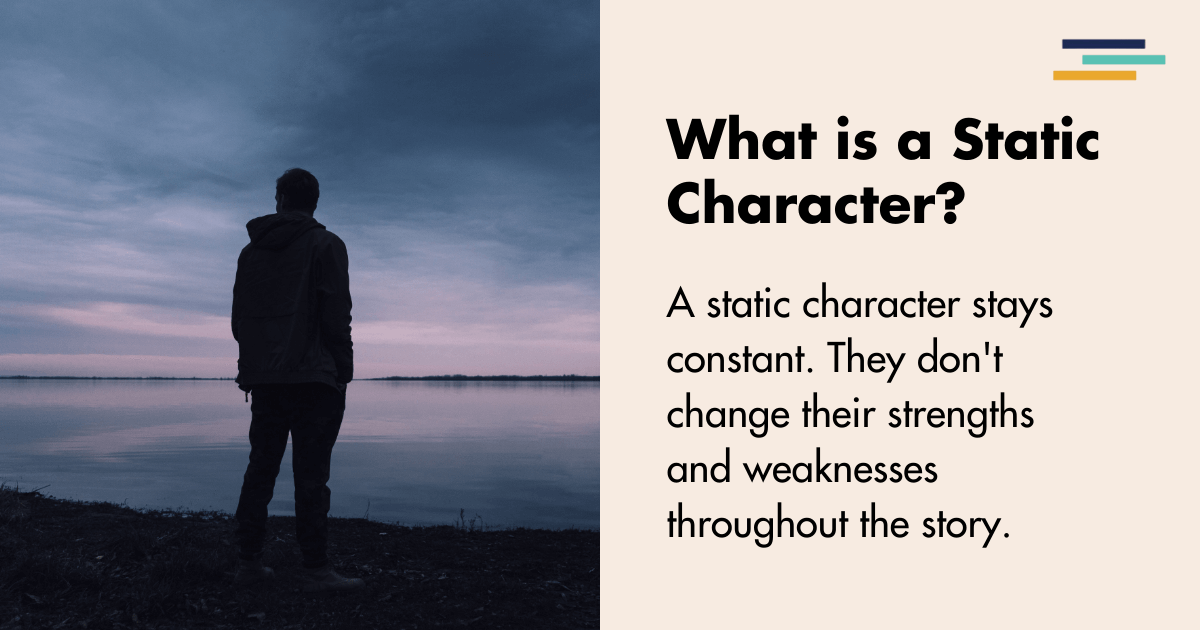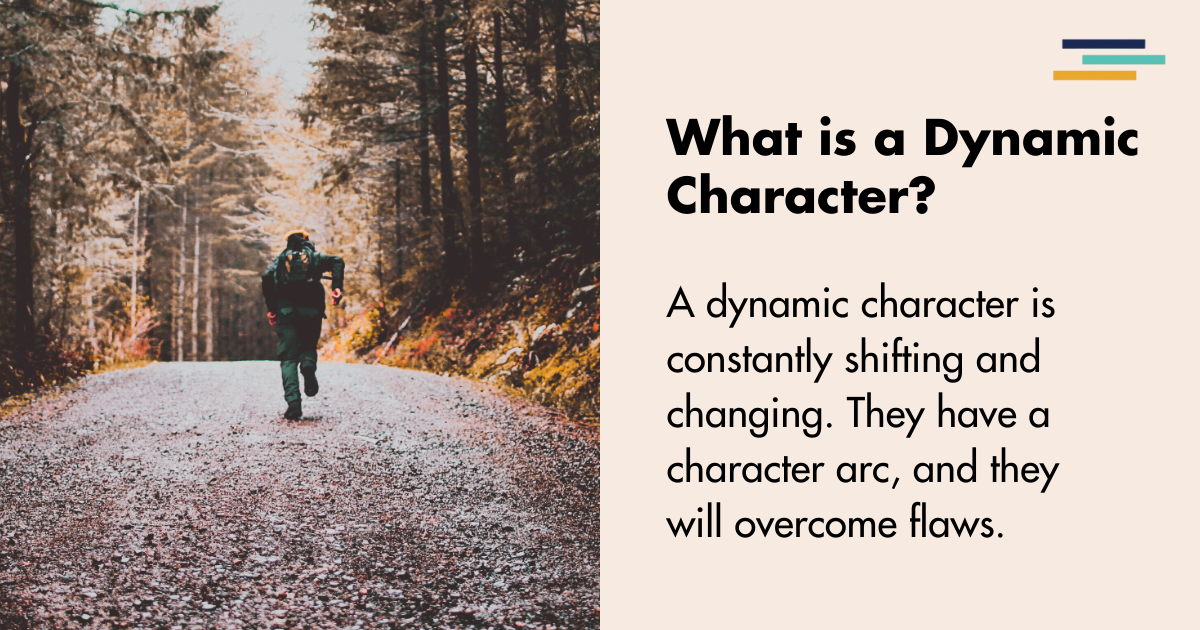
Static characters are like the static on a television. I know I’m showing my age, but if you don’t know what static on a tv is, watch Poltergeist.
The thing about static is that it doesn’t change. You get the constant crinkle of black and white lines with that same crackling noise. Just like static characters don’t change.
Now, I’m not talking flat characters. Those 2-D characters are the ones who don’t have any depth to them or are a boring cliche.
Static characters may not change, but they have plenty of depth, what we call, well-rounded characters. Static characters are still interesting to the reader.
On the other hand, dynamic characters have layers. Like a layer cake. You take all the ingredients and after they are cooked and frosted, they’ve become something completely different and not just a sum of what you started with.
What’s the Difference Between a Dynamic vs Static Character?
For those of you who know physics, you already know the difference between dynamic and static. For those of you who don’t, here are quick, simple definitions.
Static refers to something that is constant or fixed. Like a nail in the wall or the cat watching you from high up. They don’t move. Restful. Comfortable.
Dynamic refers to something that is in constant motion. Like the hands of a ticking clock, a dog’s tail, or a toddler. You get the idea. Interesting. Constantly catching your attention.
What Is a Static Character?
So, a static character is a character that stays constant. They don’t change their strengths and weaknesses. They keep them forever. Which is kind of fun since we all have flaws.
The reader knows what they are going to get when they read about them. It’s like putting on your most comfortable and worn elastic pants. They almost feel like they aren’t there.
But static characters also don’t learn any lessons and grow. There is no flash.
However, they do provide a consistent perspective throughout the story. Besides, you can’t have every character be the focus of your story. Some of them have to provide a backdrop or create that sense of familiarity.

Static Character Examples
Here’s a quick test. I’m going to list off some attributes, both good and bad, and you are going to see how long it takes to name that character. With static characters, this should be easy.
Super high Intelligence Quota (IQ). Super low Emotional Quota (EQ)
Loves the violin, dressing up as different characters, and remembers everything they see. Hates being bored and often abuses substances.
Likes difficult mysteries.
That’s right! It’s Sherlock Holmes. One of the most famous detectives and static characters in literary history. He is the same whether you read his first case, or his last (After his resurrection because the readers loved him so much).
Here’s another.
Loves animals, talks to them, and is patient with them. Sees the good in people despite being abused.
Positive. Sings to pass the time doing all the chores. Believes in magic.
Yep! It’s Cinderella.
She starts the movie singing and full of dreams, and ends the movie just the same. Only her circumstances have changed.
One More.
He loves food and gardening Thinks small and doesn’t consider himself as anything special.
He is courageous and devoted to his master and friend. Only wants to help however he can.
He is optimistic and considers the journey home as well as the journey out.
That’s right! Samwise Gamgee.
The journey there and back again hardly touched Sam. He was the same do what you have to do hobbit in the beginning and end. (I can see him still dropping eaves under his friend’s windows. Can’t you?)
What Is a Dynamic Character?
A dynamic character is constantly shifting and changing. They have a character arc. A strong external character arc will make readers turn the page!
Some character flaws must be overcome by the end of the story. They are constantly taking small steps of change throughout the story until they are a different person at the end than the one who started on the journey.
Dynamic characters can change internally or externally. They can change their outlook on life, become more trusting or less naive. They can exercise and learn to fight to defeat their opponent. Or they can do research to learn how to solve a problem.
Dynamic characters are usually the protagonist. But also sometimes supporting characters deserve their own character arc. This is common practice in romance where both sides need to learn something in order to love.

Dynamic Character Examples
Pairing our lovely Sam, we have the dynamic character of Frodo Baggins. He starts his journey as an innocent, adventure-seeking hobbit, but touches true evil and power and fails to safeguard himself from it.
Frodo is very child-like at the beginning of the story and realizes he is a bit different from the other hobbits who like to stay at home, Sam included.
The corruption of Sauron, his minions, the wound he receives on Weathertop, and the One Ring, all change Frodo so completely that he doesn’t fit back in at the Shire once his story is done and the world is saved.
He realizes that he is now even more different than other hobbits. Despite going on the journey to save the Shire, he leaves it and Sam behind to take Arwen’s place on the boat West to the Undying Lands.
In Fourth Wing, Violet is a dynamic character who changes with each decision she makes. She starts out focused on her physical weaknesses and only wanting a life of being a peaceful scribe, like her father.
But she is forced into dragon riding school by her mother. As she discovers secrets and comes into her own powers, she becomes a hero for her world.
The young woman she is at the end of book one and again at book two, would not be happy with the path she wanted at the beginning of the story.
Another dynamic woman is the protagonist of the Mercy Thompson series. Despite being an open series, Mercy changes from the obstacles she faces and overcomes in each novel.
She becomes cleverer, braver, and understands her power better each time she needs to use it. She also becomes more of a leader and less of a loner, finding her place in the pack.
When to Use Static and Dynamic Characters
Both dynamic and static characters can drive the plot, just in different ways. Both types of characters personify the themes of the story.
Static characters usually represent what would happen to the other characters if they didn’t change, causing those dynamic characters to ask questions and forcing them to make choices.
Dynamic characters are often used as engines to force the plot forward. Making plans, decisions, and doing the actions that create a cause and effect, pushing scene to scene.
As you can tell, most stories contain a balanced mixture of the two types of characters. Too many dynamic characters would make the story confusing and too many static characters would make it boring.
Static characters are often used as protagonists of an open series where they perform a function of continuity and reliability. The reader of an open series wants a different spin but not a different story. They want more of the same.
Keeping the protagonist static can be a uniting factor of an open series. Like Sherlock Holmes, Stephanie Plum, and Brother Cadfael.
Static characters are often minor characters or supporting cast in most novels, which act as foils to the protagonist’s journey. A foil is a character that underscores the transformation of another character by being on a similar path, but choosing to stay the same.
They can show either the positives or the negatives of what would happen if the protagonist didn’t change, creating dramatic irony.
In the case of Frodo, Sam is a positive foil, showing how some people are more resilient than others.
But also in The Lord of the Rings trilogy, Gollum is a static negative foil to Frodo’s journey.
Throughout the journey through the east to Mordor, Gollum shows what Frodo can become if he does not destroy the ring corrupting him quickly enough or uses it too often and becomes dependent upon it.
In Star Wars ( the original trilogy) Darth Vader is also a static negative foil to the heroes and Luke in particular. He consistently maintains his personality, behavior, and flaws.
The story’s villain, or antagonist, is often used as a static foil to the hero.
Conversely, dynamic characters are often the protagonists of closed series and most other types of stand alone stories. Their purpose in a story is to draw the reader in on an emotional level.
They create unpredictability and fulfill the reader’s curiosity about how this character will achieve their story goal or even if they will achieve their story goal.
The reader wants to go on the journey of change with that character. They want to face the conflicts with the protagonist and live through their reactions and choices.
Whether it be a positive character arc, where they become a better person, like in Alice in Wonderland when Alice learns to be a little less daydreamy and a little more serious about her schooling.
Or it could be a negative arc, like how Anakin Skywalker (in the prequel Star Wars trilogy) falls farther and farther into the darkside, eventually becoming the antagonist, Darth Vader. His character arc shows the opposite choices of what Luke Skywalker makes in his story.
Writing Static Characters Using Fictionary
The 38 Fictionary Story Elements that focus on the Character super group are the ones that can help you keep track of your static and dynamic characters.
The POV Goal Internal is often related to their character arc and the flaw they need to overcome if they are a dynamic character. Impact on POV and POV Knowledge Gained are also elements that show how the dynamic character is growing, learning, and transforming during the story.
And Story Goal Tracking shows a visual insight of the protagonist’s path towards the climax of the story, which is where the reader learns if the protagonist has truly learned their lesson.
The Fictionary StoryTeller software facilitates keeping track of all the important things an author needs to know about their characters. Like what their static personality is or where they are on their dynamic journey.


